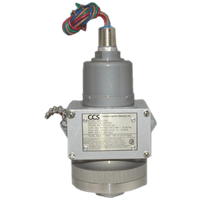Vacuum to Ultra-Low Pressure
High Sensitivity and Precision
The Vacuum to Ultra-Low Pressure Switch includes a highly sensitive pressure sensing element which is capable of detecting very small changes in pressure, both in vacuum and ultra-low positive pressure ranges. These switches come with an adjustable setpoint mechanism, allowing users to define the specific pressure level (in the vacuum to ultra-low pressure range) at which the switch will activate or deactivate. This setpoint is adjusted according to the operational requirements of the specific application.
Vacuum to Ultra-Low Pressure switches are also known as Crossover Switches.
Due to the low pressure levels being monitored, these switches are designed for high sensitivity and precision. They are capable of detecting minute changes in pressure to ensure accurate control or alarm functions. When the pressure reaches the defined setpoint, the sensing element triggers a switching mechanism, either opening or closing electrical contacts. This action can be used to control pumps, valves, compressors, alarms, or other process equipment. Constructed from materials compatible with the gases or fluids being monitored, particularly in applications involving corrosive or reactive substances. Some models are designed to operate in harsh environments or under extreme temperature conditions.
Mechanical vacuum to ultra-low pressure switches, or crossover pressure switches, use mechanical components, like diaphragms, that move or deform under pressure changes. These movements actuate the switch contacts mechanically. Suitable for many standard applications requiring basic control or alarm functions.
Vacuum to ultra-low pressure switches are used to monitor and control the pressure in vacuum systems, such as vacuum chambers, vacuum pumps, or freeze-drying equipment. They help ensure that the desired vacuum level is achieved and maintained for various industrial, laboratory, and research applications. Crossover pressure switches are used in gas handling and distribution systems handling low-pressure or vacuum gases, such as gas chromatography, semiconductor manufacturing, and chemical processing, where maintaining specific pressure levels is essential.
They are used in leak detection systems to monitor pressure drops in pipelines, tanks, or vacuum systems where a sudden drop in pressure may indicate a leak, prompting an alarm or automatic shutdown to prevent safety hazards or damage. Vacuum to ultra-low pressure switches are also utilized in heating, ventilation, and air conditioning (HVAC) systems to monitor and control low-pressure refrigerant lines, ensuring efficient operation and preventing leaks or over-pressurization. In cleanrooms and controlled environments, vacuum to ultra-low pressure switches are used to maintain specific pressure differentials to prevent contamination and ensure proper airflow.
Vacuum to ultra-low pressure switches are capable of detecting and responding to very low pressures, providing accurate monitoring and control in applications where precise pressure management is critical. They enhance safety by providing early warnings or automatic responses when pressure deviates from desired levels, preventing potential equipment damage, process disruptions, or hazardous situations. Used in automation and control systems, they enable automated control of equipment, reducing manual intervention, and improving process efficiency. Crossover pressure switches are suitable for various applications across multiple industries, including medical, laboratory, industrial, and HVAC systems as they are designed to operate effectively in challenging conditions, such as extreme temperatures, corrosive atmospheres, or high-vibration environments.
